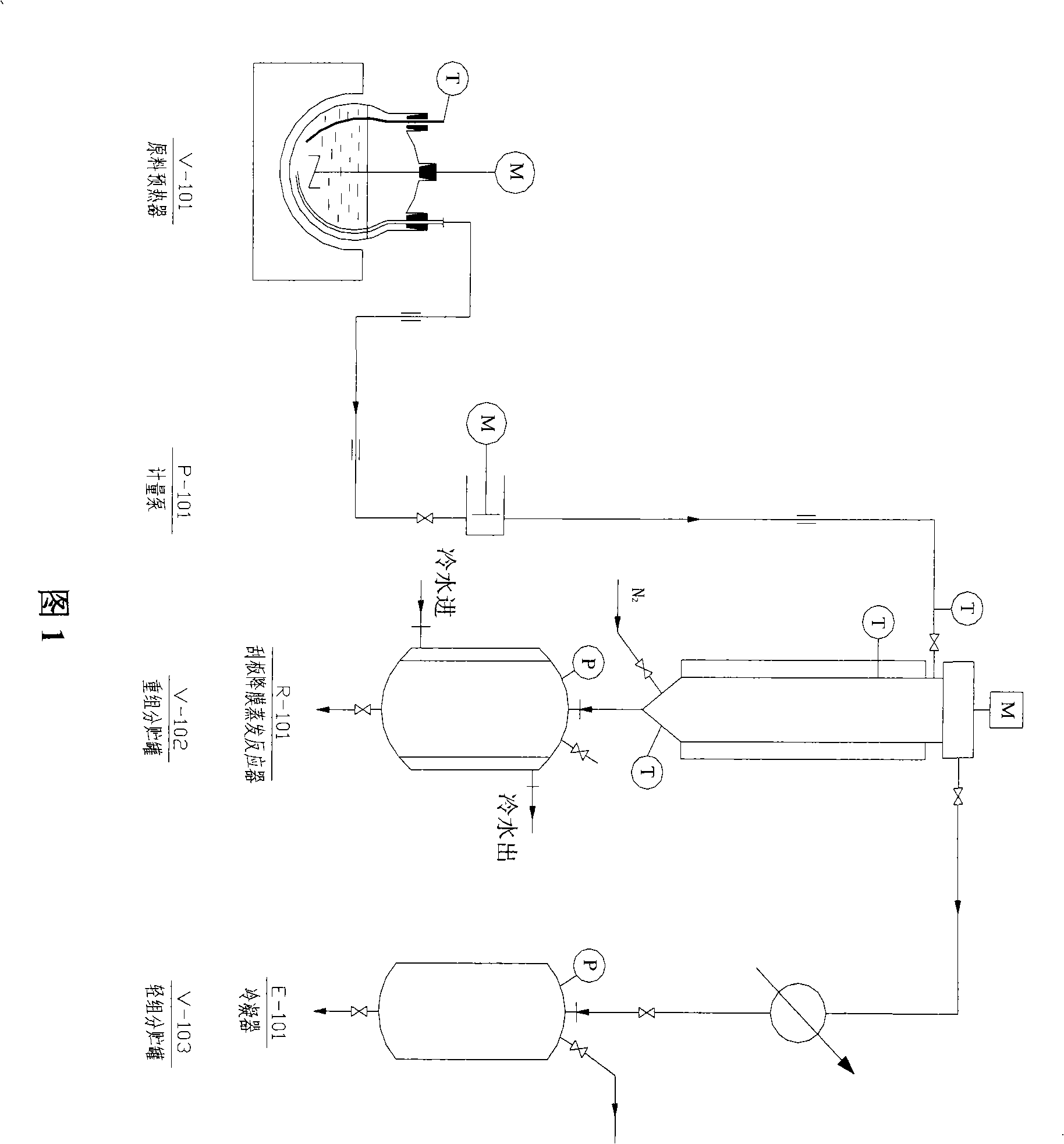Method for continuous preparation of 1,6-hexamethylene diisocyanate
A technology of hexamethylene diisocyanate and hexamethylene carbamate, which is applied in the field of continuous preparation 1, can solve problems such as environmental pollution, difficulty in separation, and high boiling point of solvents, and achieve recycling of by-products and solvents, Environmentally friendly process and short reaction time
- Summary
- Abstract
- Description
- Claims
- Application Information
AI Technical Summary
Problems solved by technology
Method used
Image
Examples
Embodiment 1
[0028] First, the air in the reaction system was replaced with nitrogen, and the temperature of the heating oil in the jacket of the scraper falling film evaporator was raised to 280°C. A mixture of N,N-dimethylaniline and toluene (blank inert solvent, weight ratio 1:1) preheated to 120°C was passed into a single-tube scraped falling film evaporator at a flow rate of 100 g / h to form a falling film evaporator. The film is vaporized, the speed of the scraper is kept at 120rpm, the temperature of the inner wall of the evaporator is controlled at 235-245°C, and the system pressure is stabilized at 0.5-0.6MPa. After the system is stable, switch the above blank inert solvent with 1,6-hexamethylene dicarbamate methyl ester solution (10g hexamethylene dicarbamate methyl ester / 100g above mixed solution) preheated to 120°C, The flow rate of 110g / h is passed into the scraper falling film evaporator to form a falling film and vaporize to start the reaction. At the same time, the collectio...
Embodiment 2
[0037] The operation is the same as in Example 1, and the use of the solvent is the same as in Example 1, replacing methyl 1,6-hexamethylene dicarbamate with ethyl 1,6-hexamethylene dicarbamate, and the concentration of the reaction raw material solution is 15g / 100g (mixed solvent), the reaction liquid flow rate is 115g / h, the inner wall temperature of the evaporator is controlled at 220-230°C, and the system pressure is stable at 0.45-0.6MPa. The rest of the operating conditions remain unchanged.
[0038] The average flow rate of fractional components at the top of the evaporator is shown in Table 3:
[0039] Table 3. Average Flow Rates of Evaporator Top Fraction Components
[0040]
[0041] The average flow rate of the material produced at the bottom of the evaporator is shown in Table 4:
[0042] Table 4. Average flow rate of materials produced at the bottom of the evaporator
[0043]
[0044] The yield of 1,6-hexamethylene diisocyanate was 97.2%, and no trimer pr...
Embodiment 3
[0046] The operation is the same as in Example 1, replacing methyl 1,6-hexamethylene dicarbamate with ethyl 1,6-hexamethylene dicarbamate, and replacing the solvent with N,N-diethylaniline and toluene according to Mixture with a weight ratio of 3:2. The concentration of the reaction raw material liquid is 15g / 100g (mixed solvent), and the flow rate of the reaction liquid is 115g / h. The inner wall temperature of the evaporator is controlled at 220-230°C, and the system pressure is stabilized at 0.20-0.3MPa. The rest of the operating conditions remain unchanged.
[0047] The average flow rate of the top fraction of the evaporator is shown in Table 5:
[0048] Table 5. Average Flow Rates of Evaporator Top Fraction Components
[0049]
[0050] The average flow rate of the extracted material at the bottom of the evaporator is shown in Table 6:
[0051] Table 6. Average flow rate of materials produced at the bottom of the evaporator
[0052]
[0053] The yield of 1,6-hexa...
PUM
 Login to View More
Login to View More Abstract
Description
Claims
Application Information
 Login to View More
Login to View More - R&D
- Intellectual Property
- Life Sciences
- Materials
- Tech Scout
- Unparalleled Data Quality
- Higher Quality Content
- 60% Fewer Hallucinations
Browse by: Latest US Patents, China's latest patents, Technical Efficacy Thesaurus, Application Domain, Technology Topic, Popular Technical Reports.
© 2025 PatSnap. All rights reserved.Legal|Privacy policy|Modern Slavery Act Transparency Statement|Sitemap|About US| Contact US: help@patsnap.com



